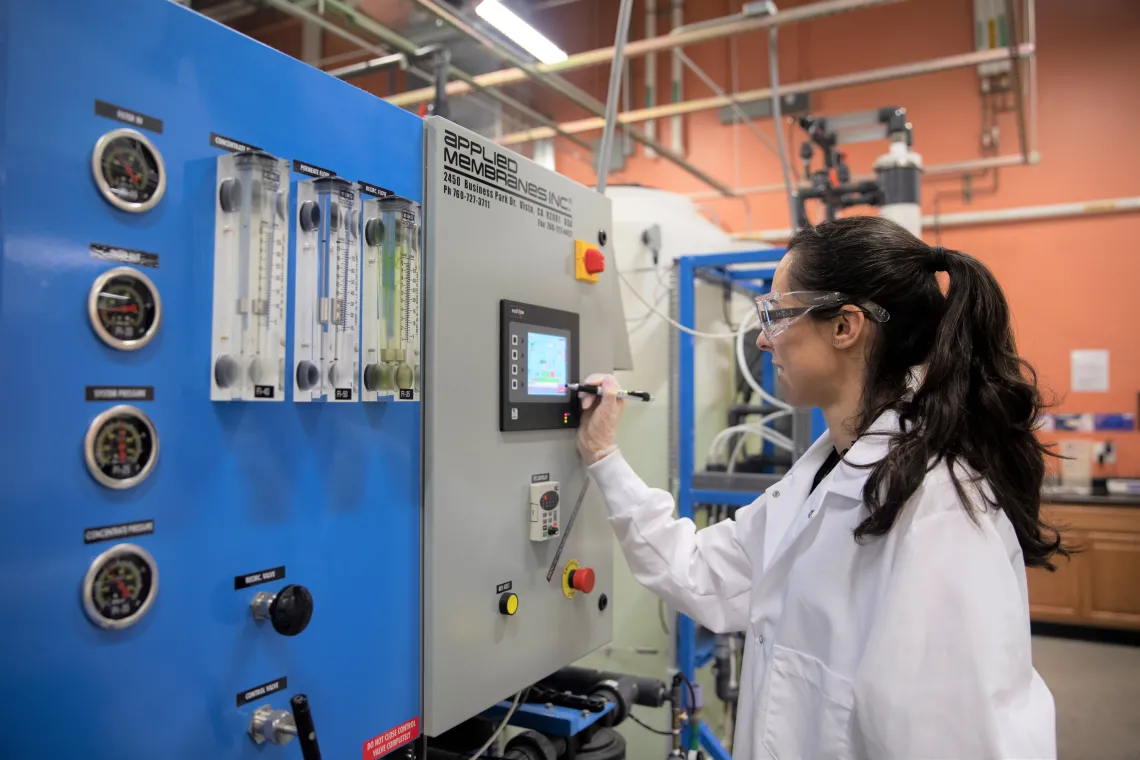WEST publication selected for JMS Editor’s Choice

Dr. Souza-Chaves working on the Reverse Osmosis (RO) system at WEST Center
In the recently-published article, “Extending the life of water reuse reverse osmosis membranes using chlorination,” Dr. Bianca M. Souza-Chaves, a member of the ART Lab, and co-authors from the University of Arizona Water & Energy Sustainable Technology (WEST) Center illustrate how controlled oxidation is a practical method for recovering end-of-life reverse osmosis (RO) membranes and restoring permeability without compromising particle selectivity in water reuse applications.
The article explains how membrane technologies are an efficient solution to water purification needs, with RO being especially useful in multiple applications. This pressure-driven water purification process uses a semi-permeable membrane to separate chemical and biological contaminants (larger and/or charged particles) from drinking water. RO has become an essential barrier approach used to produce high quality water for potable reuse [1]. “However, aging occurs throughout the membrane’s lifetime and end-of-life RO membrane management has become a global environmental and economical concern” [2,3]. Membrane replacement is costly for operations, and a large number of membrane elements – estimated 800,000 – are disposed of in landfills each year [4].
To address disposal concerns and reduce operation costs, various efforts have been undertaken to determine an optimal method for extending membrane lifespan. One possible solution is modifying RO membrane surfaces by exposing the membranes to a strong chemical oxidant such as free chlorine (NaOCl), hydrogen peroxide (H2O2), or potassium permanganate (KMnO4) [5,6]. Periodic membrane modification using low oxidant exposure doses has been found to gradually remove fouling and scaling not removed by regular chemical cleanings and progressively increase water permeability. This approach may also maintain membrane selectivity and thus preserve high-quality water production while reducing operational costs.
As described by WEST Center researchers, previous work had limitations overcome by this recent study:
“Although controlled chemical exposure has the potential to extend RO membrane lifespan, most studies tested or validated short-term laboratory cross-filtration systems using synthetic water to modify the membranes. Therefore, a knowledge gap exists in progressively modifying RO membranes by chemical oxidation at a continuous engineering-scale system using treated municipal wastewater. Furthermore, there is a lack of studies investigating the long-term performance of the oxidized membranes and their efficacy in removing organic, inorganic, and naturally occurring viruses for water reuse application.
In this study, controlled chemical modification was conducted on a continuous engineering-scale RO system treating reclaimed water for almost three years. The overall objective was to restore the apparent water permeability of end-of-life RO membranes and understand the changes in membrane characteristics caused by membrane surface modification due to in situ chlorination” [3].
In this study, researchers at WEST Center evaluated water, salt, and organic permeability (including breakthrough viruses) as a function of chlorine exposure dose in an engineering-scale RO system. The exposure dose protocol as well as implications on membrane permeability and selectivity after periodic chlorine exposure were discussed. Results suggest that “targeted chlorination may extend RO membrane lifespan by increasing apparent water permeability while maintaining RO-like selectivity” [3]. For details about the study methods and specific findings, see the journal article linked here or above.
Financial support for the study was provided by the City of Phoenix, Water Research Foundation, California State Water Resources Control Board, and Metropolitan Water District of Southern California. The article will be published in the February 2022 issue of the Journal of Membrane Science (Volume 642). It was made available online in Fall 2021, and was selected as a JMS Editor’s Choice Article in September 2021.
References
[1] D.M. Warsinger, S. Chakraborty, E.W. Tow, M.H. Plumlee, C. Bellona, S. Loutatidou, L. Karimi, A.M. Mikelonis, A. Achilli, A. Ghassemi, L.P. Padhye, S.A. Snyder, S. Curcio, C.D. Vecitis, H.A. Arafat, J.H. Lienhard, A review of polymeric membranes and processes for potable water reuse, Prog. Polym. Sci. 81 (2018) 209–237.
[2] J. Senán-Salinas, R. García-Pacheco, J. Landaburu-Aguirre, E. García-Calvo, Recycling of end-of-life reverse osmosis membranes: comparative LCA and cost-effectiveness analysis at pilot scale, Resour. Conserv. Recycl. 150 (2019) 104423.
[3] Bianca M. Souza-Chaves, Mohammed A. Alhussaini, Varinia Felix, Luke K. Presson, Walter Q. Betancourt, Kerri L. Hickenbottom, Andrea Achilli, Extending the life of water reuse reverse osmosis membranes using chlorination, Journal of Membrane Science 642 (2022) 119897.
[4] R. García-Pacheco, J. Landaburu-Aguirre, P. Terrero-Rodríguez, E. Campos, F. Molina-Serrano, J. Rabad´an, D. Zarzo, E. García-Calvo, Validation of recycled membranes for treating brackish water at pilot scale, Desalination 433 (2018) 199–208.
[5] J.M. Veza, J.J. Rodriguez-Gonzalez, Second use for old reverse osmosis membranes: wastewater treatment, Desalination 157 (2003) 65–72.
[6] J.J. Rodríguez, V. Jim´enez, O. Trujillo, J. Veza, Reuse of reverse osmosis membranes in advanced wastewater treatment, Desalination 150 (2002) 219–225.

